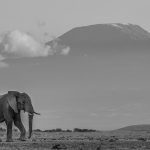This month we are reviewing the Selous Game Reserve in Southern Tanzania. You will find below an introduction to the park and the man from whom it took its name. The text is written by one of our consultants Annabel Skinner, author of the Cadogan Guide to Tanzania.
Stay tuned to the Tanzania Odyssey Blog for the next month as Annie reviews the different lodges throughout the park.
Frederick Courtney Selous and the Selous Game Reserve
The game reserve was named in 1922 after an English explorer, Captain Frederick Courtney Selous, who met his fate beneath Sugar Mountain in Beho Beho, in combat with the Germans during the First World War. His name is generally pronounced with a French affectation that does not enun- ciate the final ‘s’ – ‘seloo’ – and this is the how the park’s name is pronounced today. Selous was the son of a chairman of the London Stock Exchange, who finished his public school education with a passion for Africa inspired by the writings of Livingstone. In 1871, rebelling against his family’s desires for him to enter the medical profession, he travelled to South Africa and embarked on a now legendary expatriate lifestyle. A friendship with King Lonbengula in Bulaweyo allowed him to travel freely through Matabeleland, one of the last areas of wild big-game herds that had survived extermination by the first Europeans. Selous earned himself a reputation as the ‘greatest of the white hunters’, distinguishing himself from other trigger-happy expats by his keen interest in nature, and propounding early theories on conservation and natural history – which did not entirely curtail his career as an animal-killer. Selous’s skills as a tracker and hunter, as recorded in his bestselling accounts A Hunter’s Wanderings in Africa sold to an enthralled audience in Victorian England. Widely celebrated, he began leading safaris through the bush; he organized an extravagant hunting safari for Roosevelt and entourage in 1909.
Retired in Surrey by the outbreak of the First World War, Captain F.C. Selous felt that he could contribute to the war effort in East Africa. He joined the 25th Royal Fusiliers in Nairobi and pursued retreating German Schutztruppe through southern Tanzania, an arduous pursuit in which he refused to ride on horseback, insisting on marching alongside his depleted column of men. Each night when his men retired to their tents, Selous disappeared into the bush with his butterfly net to collect speci- mens. The captain was 64 when he died in action, killed by a German sniper at Beho Beho on the Rufiji River. Trenches remain in the Selous, a legacy of the German campaign, led by commander Paul von Lettow Vorbeck, who resisted more numerous allied troops here for four years.
More recently, another expat Englishman, Constantine Ionides, has developed a reputation as a hunter with a bent for conservation, playing a key role in controlling elephant poaching with the support of Tanzanian Game Officer Mzee Madogo in the 1990s. Now the reserve is divided between photographic tourism and hunting, the latter being the major source of income required to police the area against poaching and thus support the entire conservation area. Around 210 foreign hunters pay a vast sum of money to shoot up to 2,000 designated animals, the reserve’s quota, between July and November. The aim is to restrict human impact. Plans are under way to expand the area for photo- graphic tourism on the south side of the Rufiji River.
The Selous Game Reserve
The Rufiji River with its lagoons, sand banks and lakes, and the surrounding forests and woodlands that make up the northern, accessible part of the Selous Game Reserve creates a very unusual safari environment. The spectrum of wildlife is equally diverse, and is distinct in that this southern location attracts a unique combination of eastern and southern African wildlife, both resident and migratory – notably a curious and colourful assortment of more than 440 known species of birds and a healthy population of African hunting dog. Covering almost 50,000 square kilometres, an area greater than the size of Switzerland, the Selous Game Reserve is one of the largest areas set aside for wildlife preservation anywhere in the world, although only a small northern portion is allocated for photographic tourism – access to the southern region is strictly prohibited. This is also an area that naturally appeals to a photographic lens, as the waterways and plains reflect all the changing colours of the sun and attract numerous well-feathered water birds and raptors, alongside a healthy population of predators. The Selous was declared a World Heritage Site by the UN in 1982, but the number of visitors is still fewer than 5,000 a year and this lack of mass tourism ensures that those who do visit the Selous enjoy a true wilderness experience. The vast area contained within the boundaries of the Selous Game Reserve accounts for five per cent of the landmass of Tanzania, yet there are just a few options for tourist accommodation, all high-quality, low-impact lodges that maintain high standards. The freedom to take walking and boating safaris within the reserve means that guiding standards are also especially good and can extend to include excellent options to fly-camp overnight in the bush. All of these allow visitors to enjoy varied perspectives on life in this green and lush southern corner. The tourist sector north of the Rufiji River extends to Stiegler’s Gorge in the west and the TAZARA railway in the north, and contains all the various forms of vegetation to be found in this ecosystem. The combination of the river – its meandering streams, ox-bow lakes and swamplands – with open wood- lands, plains and dense thicket forests, makes the Selous an interesting ecological environment and an ideal location to explore over a number of days by vehicle, on boat trips and on foot.
Click to see video Selous Game Reserve
The scenery of Selous Game Reserve is varied, with unusually green grasses and tangles of vege- tation, and provides a film-depleting string of photo opportunities with each turn in the path. The river routes are characterized by legions of tall borassus palms along the banks that grow up to 25m tall, and leave a tall headless totem when the water courses change direction and they become too thirsty to survive. The same demise is thought to explain the spooky silhouettes of ancient leadwood trees (Combetum imberbe) that remain intact, preserved when they die after up to two millennia of life, leaving a skeletal perch for songbirds and raptors that retains a perfectly still photogenic pose. The Selous conserves a surprisingly colourful African landscape, and the white forms of the leadwoods are in stark contrast to the surrounding vibrancy of well-watered greens and a ranging palette of sandy terracottas that reflect with the moods of the sun on the waters. The eastern area of the reserve around Selous Safari Camp, Rufiji River Camp and Impala Mbuyu Camp is a grassy woodland, with a mass of terminalia trees and sweet-scented African mahogany trees providing fragrant shady areas through which to enjoy walking safaris. Further north, and westwards towards the rise of the Beho Beho Mountains and the camp of the same name, the land is mainly covered by low miombo woodland. It takes a full daytrip to travel between these two areas from the respective camps.This area can be reached as a full day trip from southeasterly camps such as Selous Safari Camp. The western reaches of the reserve are the least developed, with Sand Rivers Selous presently the only camp in the area; its elevation gives magnificent views across the woodlands and plains of the southerly hills. Here the Rufiji River forms a narrow 8km creek through a chasm in the hard rock. This scenic region is now called Stiegler’s Gorge, after an unfortunate Swiss fellow who came to a sorry end when he met an elephant here at the turn of the last century.






